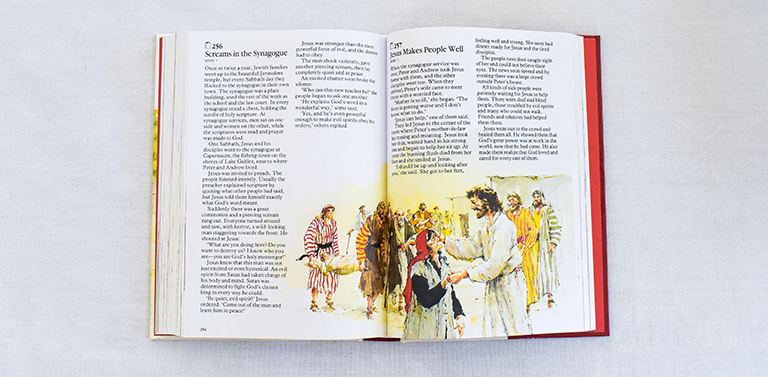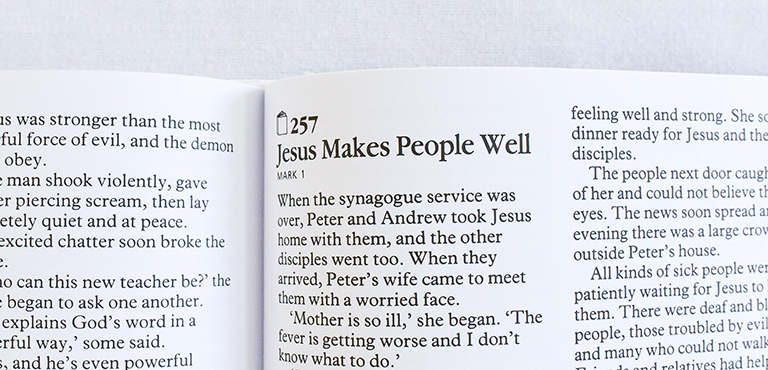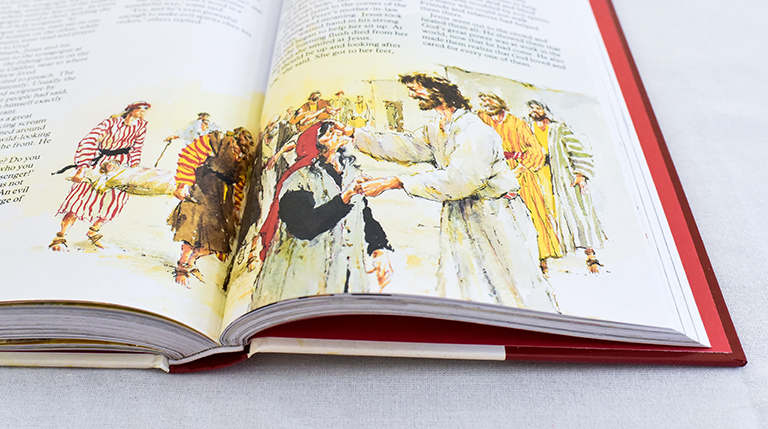The Children’s Bible in 365 Stories is one of so many children’s Bibles. It’s easy to feel overwhelmed by the variety and unsure which is best for your bookshelf. So, here at ICM, we’ve compiled our thoughts in this blog series where we’ll be reviewing some of today’s most popular children’s Bibles. Once you find your fave children’s Bible, check out our post on ways of reading scripture with your kids to get the most out of it!
Quick Facts about The Children’s Bible in 365 Stories
- 416 pages
- Author: Mary Batchelor
- Illustrator: John Haysom
- Storybook format (a retelling of some of the Bible)
- Age Range: 8-12 years old
A Closer Look
To begin, there’s no perfect choice for all children everywhere or even for your own child. Each children’s Bible is a mixture of aspects to love and those that invite palm to forehead moments. So, in this series of reviews, we’ll always include what we think to be the pros and cons of each Bible. And we’ll discuss whether or not we’d recommend it to our friends. So, let’s dive in and take a closer look at The Children’s Bible in 365 Stories.
Pros of The Children’s Bible in 365 Stories
Table of Contents Included: It has a very clear table of contents, which makes finding stories easy.
Classic Stories Included: It includes all the classic stories you’d hope for from a children’s Bible.
Biblical Passages Cited: Each story gives the biblical passages from which the author drew. As a result, biblical literacy increases, and reference is easy.
Appropriately Illustrated Characters: Figures are shown with olive skin and dark hair, honoring the Bible’s Middle Eastern context.
Digestible Story Length: One to two chapters of scripture are paraphrased into a handful of paragraphs for each day of the calendar year. So, it’s easy to hold young readers’ attention.
Appropriate Font Size: The font is large enough for relatively new readers to read easily but small enough for whom the bible is intended.
Clearly Laid Out: The format is easy to follow and simply composed. Titles of stories are obvious, it follows the organization of Hebrew and Greek Testaments, and each day’s scripture is accompanied by a number 1-365.
Lack of Interpretation: At the end of each story there is no prayer or commentary. As a result, parents and ministry leaders create content appropriate to their context.
The Children’s Bible in 365 Stories
Exclusively Masculine Language for God: As we’ve written in past reviews, God is neither male nor female but possesses a nature far more complex and integrated. Consequently, if we are to use one gender to metaphorically describe God, we must use all genders. If not, using non-gendered language for God is ideal. This is standard practice in most seminaries; there is no reason it shouldn’t be common practice in the pulpit and faith education of young ones.
Unclear Illustrations: The illustrations are gestural in style. As a result, they are at times a bit hard to decipher. The reader may struggle in these instances to put together what is happening and who is who.
Unfamiliar Story Titles: Some of the story titles are not the most commonly used. Difficulty can arise when children transition to an adult bible when they aren’t familiar with the story titles.
No Name Plate Included: Without a nameplate, gifting this bible to children within a church ministry would be less than ideal.
Conclusion
None of us will find THE Bible that nails it all for us, of course. The Children’s Bible in 365 Stories has some good things going for it and some less than ideal aspects, also. The inclusion of a clear table of contents and the classic stories, appropriate illustrations, and font size along with digestible story length, a clear layout, and lack of interpretation are all positive aspects. The challenges lie in the exclusivity of masculine language for the Divine, unclear illustrations, unfamiliar story titles, and the lack of a nameplate. For use at home or one-on-one in Sunday school, this may be a good choice. Conversations about illustrations and language can more easily happen there. On the whole, we would recommend this Bible. If you’re willing to do some added work through intentional conversation, it could be a good fit for you.
We hope this review has been helpful. Share what children’s Bibles you have and love in the comments below!






Pam Schrock says
Our son struggled to read, so we found The Picture Bible to be a tremendous help to him. It’s been around for ages and is written like a graphic novel or comic book. FABULOUS!!!!
T. Evans says
I used to LOVE reading this book as a kid. I was so worried I wouldn’t be able to find it for my kids since it came out so long ago but was able to order a brand new copy today. I do agree it is a bit generalized but I think it’s a great way to introduce kids to bible stories.
Trina says
I remember this being the first book I ever read, at like, 4 or 5 years old. It helped my vocabulary and broadened my perspectives and most importantly, taught me all the Bible stories I know today. I always wanted to gift my kids this book as well, but I am having it difficult getting a site that sells it (says out of stock everywhere). Please help, baby is due soon…